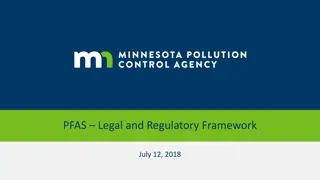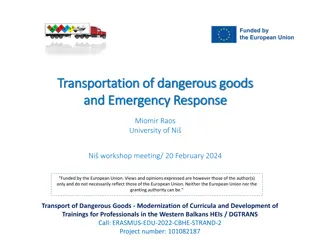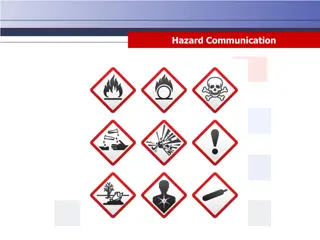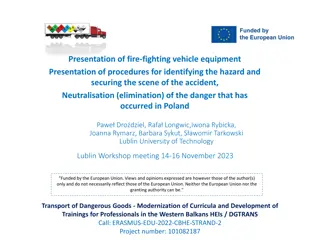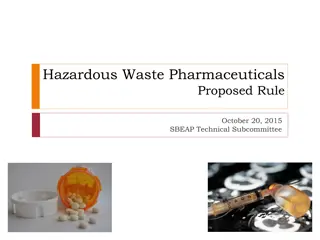Emergency Services Unit and Hazardous Materials Management in Louisiana
The Emergency Services Unit (ESU) in Louisiana, along with Hazardous Materials management, focuses on preparing, preventing, responding, recovering, and mitigating hazardous incidents. Their goals include public safety through education, training, enforcement, and support of regulations at the state
5 views • 35 slides
PP Jumbo Bags in Hazardous Material Handling
In industries dealing with hazardous materials, safety is paramount. From chemical manufacturing to waste management, proper containment and transportation of hazardous substances are critical to prevent accidents, protect workers, and comply with regulations. This is where PP jumbo bag step in as i
4 views • 5 slides
Preventing Occupational Exposure to Hazardous Drugs: Module 2 Overview
This training module focuses on preventing occupational exposure to hazardous drugs, covering routes of exposure, hierarchy of controls, recommended procedures, and control measures. Prior review of Module 1 is advised for a comprehensive understanding of the topic.
1 views • 33 slides
Occupational Exposure to Hazardous Drugs: Risks and Prevention
Learn about the hazards of exposure to hazardous drugs, including potential health risks such as cancer, nausea, reproductive toxicity, and organ damage. Explore training modules, drug categories, and a list of hazardous drugs to ensure workplace safety. Discover NIOSH criteria for identifying hazar
1 views • 42 slides
Overview of Drugs and Cosmetics Act, 1940
The Drugs and Cosmetics Act of 1940 was enacted to regulate the import, manufacture, distribution, and sale of drugs and cosmetics in India. The Act aims to ensure high standards of medical treatment, prevent substandard drugs, and establish advisory boards for different types of drugs. It sets out
0 views • 49 slides
Hazardous Drug Cleaning and Decontamination Training Overview
This presentation provides an overview of training on deactivating, decontaminating, cleaning, and disinfecting hazardous drug areas. It covers essential steps, personal protective equipment, materials, timing, and validation criteria. All areas handling hazardous drugs must undergo deactivation, de
0 views • 23 slides
Sources of Crude Drugs: Plant, Animal, Marine, and Tissue Culture in Pharmacognosy
Crude drugs are natural substances obtained from plants, animals, and minerals. They are used without much processing and have therapeutic properties. Different plant parts like leaves, flowers, fruits, seeds, roots, bark, and stems yield various important drugs. Animals and minerals also serve as s
2 views • 19 slides
Proposed Amendments for Hazardous Material Release Reporting Regulations
Amendments to the hazardous material release reporting regulations include consolidating definitions, adding new definitions, changing the administering agency, updating citations, and altering notification timeframes. The amendments aim to enhance emergency response and improve reporting procedures
1 views • 18 slides
The Drugs and Magic Remedies (Objectionable Advertisements) Act, 1954 Overview
The Drugs and Magic Remedies (Objectionable Advertisements) Act of 1954 regulates the advertising of drugs and remedies claiming magical properties in India. It defines drugs and magic remedies, prohibits certain types of advertisements related to drugs, and aims to control misleading marketing prac
0 views • 12 slides
Overview of Drugs and Cosmetics Act, 1940 and Its Rules 1945
The Drugs and Cosmetics Act of 1940 and its Rules of 1945 were established to regulate the import, manufacture, distribution, and sale of drugs and cosmetics in India. The Act ensures that only qualified individuals are involved in these processes and aims to prevent the entry of substandard or spur
2 views • 116 slides
Overview of Anxiety Disorders and Antianxiety Drugs
Anxiety disorders are conditions characterized by excessive worry and fear that can interfere with daily life. Common types include generalized anxiety disorder, panic disorder, phobias, and OCD. Treatment options include psychotherapy and anxiolytic drugs such as benzodiazepines, 5HT1A agonists, be
0 views • 25 slides
Overview of Anticestodal Drugs in Veterinary Pharmacology
Anticestodal drugs play a crucial role in combating tapeworm infections in veterinary medicine. These drugs are classified into taeniafuges and taenicides, with examples of natural and synthetic compounds highlighted. Natural compounds like pumpkin seeds and male fern are traditionally used for thei
0 views • 29 slides
Overview of Central Drug Standard Control Organisation (CDSCO) in India
The Central Drug Standard Control Organisation (CDSCO) is the main regulatory body in India for pharmaceuticals, medical devices, and clinical trials. It functions under the Directorate General of Health Services, Ministry of Health and Family Welfare, Government of India. The CDSCO is responsible f
0 views • 18 slides
Understanding Generic Drugs and Brand Name Medications
Generic drugs are identical copies of brand-name medications in dosage, strength, quality, and intended use. They contain the same active ingredients but are sold under their chemical name. This article explores the basic differences between generic and brand-name drugs, when generic drugs are marke
0 views • 20 slides
Hazardous Materials Awareness Training Overview
This training module provides essential information on shipping and receiving hazardous materials, including definitions, objectives, levels of training required, shipping regulations, and penalties for non-compliance. It covers the importance of training, regulatory guidelines, and the potential co
0 views • 21 slides
Overview of Antitubercular Drugs: Introduction, Classification, and Applications
Tuberculosis is a chronic granulomatous disease caused by Mycobacterium bovis in ruminants and Mycobacterium avium in dogs and pigs. These bacteria have a unique waxy appearance due to their cell wall composition, providing a shield against pharmacological compounds. Antitubercular drugs play a cruc
3 views • 28 slides
Understanding Renal Block: Drugs, Excretion, and Treatment Essentials
Renal block plays a crucial role in drug excretion, with processes like glomerular filtration and tubular secretion affecting drug elimination. Factors like blood flow, physiochemical properties, and urine pH influence renal excretion of drugs. Competition between drugs for transporters can have ben
0 views • 10 slides
Advances in Antimicrobial Drugs: Selective Toxicity and Classification
The development of antimicrobial drugs has significantly improved therapeutics by controlling infections and preventing complications. These drugs target invading microorganisms using selective toxicity, sparing host cells. Antimicrobial drugs are classified based on site, mechanism of action, and c
0 views • 30 slides
Classification of Drugs Acting on Central Nervous System
The Central Nervous System (CNS) plays a crucial role in coordinating the body's functions and responses to the environment. Drugs acting on the CNS can be classified into CNS stimulants and CNS depressants. CNS stimulants include spinal, medullary, and cortical stimulants, with various direct and i
0 views • 10 slides
Hazardous Materials Business Plan Training Program
Facilities subject to the Hazardous Materials Business Plan (HMBP) Program must implement a training program for employees on hazardous materials safety and emergency response. This includes initial training for new employees within 30 days of hire and annual refresher training. Training covers safe
1 views • 73 slides
Safe Handling of Hazardous Drugs: Training and Protocols
This presentation provides guidelines for the safe handling of hazardous drugs during receipt and unpacking. It covers topics such as personal protective equipment, inspecting packages for damage, and proper unpacking procedures. Staff involved in medication handling from suppliers should undergo th
0 views • 16 slides
Overview of PFAS Legal and Regulatory Framework
This document outlines the legal and regulatory framework surrounding PFAS (per- and polyfluoroalkyl substances), including hazardous waste designation, historical context at 3M sites, and the definition of hazardous substances and waste according to Minnesota statutes. It also discusses the potenti
0 views • 19 slides
Hazardous Drugs Spill Control and Clean-Up Guidelines
Learn about safe handling of hazardous drugs through spill control and clean-up procedures. This presentation covers identifying spills, using spill kits, cleaning spills, reporting, and documentation. Proper training and procedures are essential to protect personnel from exposure risks. Always foll
0 views • 27 slides
Understanding the Impact of Drugs on Pregnancy Development
This lecture covers factors influencing placental transfer, harmful effects of drugs at different developmental stages, FDA classifications of drugs, and teratogenic drugs. It explains how drugs cross the placenta, including physiochemical properties and stage of development affecting transfer. The
0 views • 10 slides
Hazardous Plants Identification and Safety Guide
Explore the five main hazardous plants found in and around Peterborough County, including stinging nettle, poison ivy, poison sumac, wild parsnip, and giant hogweed. Learn about their distinct features, hazardous parts, symptoms of contact, and safety precautions. Discover how to identify these plan
0 views • 4 slides
Safe Handling of Hazardous Drugs: Training Overview
This presentation provides essential information on safe handling practices for transporting hazardous drugs within healthcare facilities. It covers training modules, types of transport activities, personal protective equipment requirements, packaging guidelines, and safety criteria for labeling and
0 views • 17 slides
Understanding Hazardous Materials Transportation Regulations
Legislation governs the transportation of hazardous materials, including strict rules for packaging and transport. Dangerous goods are classified into nine categories, each with specific hazards. Consignors must identify, label, and package goods properly to prevent risks. Biological materials requi
0 views • 9 slides
Hazardous Waste Management Regulations in Pennsylvania
The hazardous waste management regulations in Pennsylvania outline compliance standards for handling hazardous waste, including storage, identification, transportation, recordkeeping, and emergency response. These regulations incorporate both federal guidelines under RCRA and state-specific requirem
0 views • 122 slides
Effective Hazardous Waste Management Strategies for Electronics and Batteries
Implementing proper waste management strategies for electronics and batteries is crucial to promote recycling and prevent environmental harm. The policy outlines procedures for disposing of electronic waste, including the collection of usable equipment for surplus handling. Additionally, it emphasiz
0 views • 9 slides
Proper Handling and Disposal of Hazardous Drugs and Waste
Guidelines for the safe handling and disposal of hazardous drugs and waste in healthcare facilities. The content covers training modules, waste collection, sources of healthcare waste, disposal methods, and legal regulations related to the disposal of hazardous drugs. Various types of healthcare was
0 views • 21 slides
Modernization of Curricula for Transportation of Hazardous Materials and Emergency Response Workshop
This workshop, funded by the European Union, focuses on modernizing curricula and developing training programs for professionals in the Western Balkans HEIs on the transportation of dangerous goods and emergency response. Various methods of transporting hazardous materials, such as cargo tanks, chem
0 views • 35 slides
Importance of Hazard Communication Training for Workplace Safety
Hazard communication training is essential for creating a safe work environment by helping individuals recognize and manage hazardous materials effectively. Understanding the Globally Harmonized System (GHS) and following hazard communication laws can improve workplace safety, protect human health,
0 views • 36 slides
Proper Procedures for Dealing with Hazardous Substance Spills
This presentation covers the procedures for identifying and securing hazards at the scene of an accident, as well as neutralizing dangers in Poland. It includes information on fire-fighting vehicle equipment, such as different nozzles and tools used by the fire brigade. Steps for dealing with hazard
0 views • 7 slides
Hazardous Waste Pharmaceuticals Proposed Rule Overview
This briefing provides an in-depth look at the Hazardous Waste Pharmaceuticals Proposed Rule from October 20, 2015. It covers which pharmaceuticals are considered hazardous waste, major provisions of the proposal, examples of listed hazardous waste pharmaceuticals, and the flow of hazardous waste ph
0 views • 40 slides
Occupational Safety Training in Handling Hazardous Drugs
This presentation provides guidelines and training modules for staff responsible for cleaning areas where hazardous drugs are handled, including laundry and housekeeping tasks. Topics cover personal protective equipment recommendations, cleaning procedures, disposal processes, and hygiene practices.
0 views • 18 slides
Hazardous Materials Safety Guidelines for Room XXX in Building
This document outlines the hazardous materials safety guidelines for Room XXX in the building, highlighting prohibitions on eating, drinking, and smoking, as well as the requirement for safety glasses. It includes contact information for primary and secondary area contacts, the department head, and
0 views • 4 slides
Hazardous Waste Facility Parceling Process
Hazardous Waste Facility Parceling involves subdividing permitted facilities into separate property tracts to facilitate ownership transfers. The process allows for the transfer of portions of the property, including hazardous waste management units, with specific actions and requirements for new ow
0 views • 5 slides
Youngstown State University Hazardous Waste Program Overview
The Hazardous Waste Program at Youngstown State University follows a cradle-to-grave approach, encompassing laws, regulations, inspections, roles, and responsibilities related to hazardous waste management. It delves into the identification, labeling, disposal, and transportation of hazardous waste,
0 views • 18 slides
RIPA Technical Meeting Grand Rapids, MI
The Pipeline and Hazardous Materials Safety Administration's (PHMSA) strategic framework emphasizes innovation and safety in transportation of energy and hazardous materials. Goals include cultivating excellence, building trust, and pursuing operational excellence. Initiatives such as IBC repair tes
0 views • 11 slides
Safe Transportation of Hazardous Materials: A Comprehensive Guide
This comprehensive guide explores the safe transportation of hazardous materials, covering topics such as requirements for hazmat drivers, classifications of hazardous materials, handling procedures, placarding, and regulatory compliance. Learn about identifying, packaging, labeling, and transportin
0 views • 31 slides





















